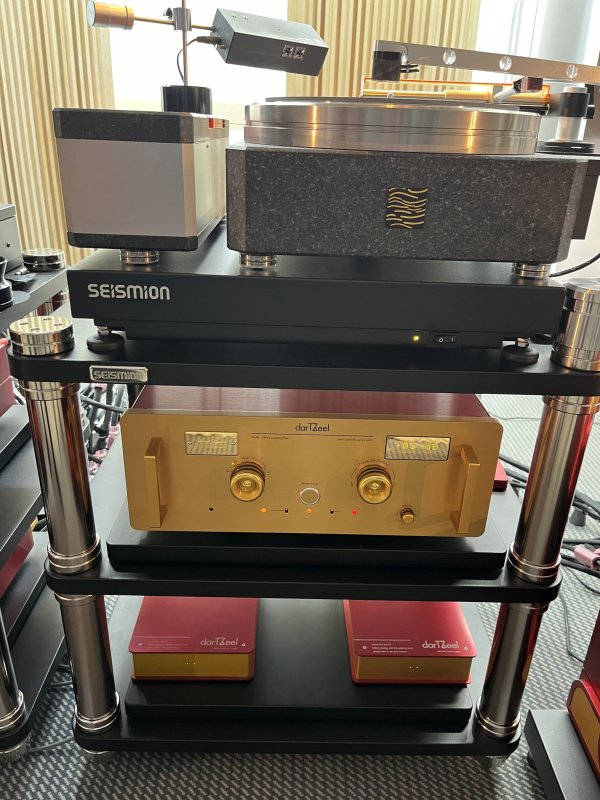This answer seems to be off-topic. There won't be any speaker sitting on a metal plate, so what is the point mentioning this...You have a point. Playing a mono track with one speaker is perfectly normal but speaker company can be sensitive about that. If I were them I would be more sensitive and solemnly concerned about my speakers being demoed sitting on a metal plate with wedges underneath.
Seismion - new active isolation platform from Germany
- Thread starter TLi
- Start date
You are using an out of date browser. It may not display this or other websites correctly.
You should upgrade or use an alternative browser.
You should upgrade or use an alternative browser.
When @TLi suggested using a metal stand in his post below:This answer seems to be off-topic. There won't be any speaker sitting on a metal plate, so what is the point mentioning this...
Your response was:May I suggest that Seismion makes metal stand which is just slightly higher than Altas, find a way to slide the metal stand under the speaker when Altas is off, so the speaker is not standing on Altas.
TLi, that is exactly what our plan is.
So, I learned from you that you're going to use a metal stand. Metal or not it's not important. Placing speakers over a stand is my point. My prior answer is in the center of topic because it directly affects evaluating the effectiveness of seismion. @Kingrex shared his concerns regarding speaker manufacturers' responses about using one speaker and my response was related with that suggesting that there shouldn't be any concern about using one speaker. Maybe all have been misunderstood.
Last edited:
This is Sebastian, I want to add that the main idea of doing this new approach was by Gregor a friend of Aldo (Sigma Acoustics) and Marcus and me. He is taking care of the acoustics in Aldo's listening room. He is well aware of the disadvantages of putting the speakers higher, however, everything is a trade off and one has to decide what gives the best overall result.
His point is that in the exhibition listening rooms it is not possible to play music at higher volumes because of the strong vibrations of the walls and floors and interference respectively. Also it is not possible to reduce low frequency vibration with carpets and light weight wood constructions, only heavy walls and floors would help to reduce their acceleration and sound emission respectively. This is mainly due to structure-borne sound transmission. The idea is to cut this transmission path between the speakers and the floor.
However, it is not possible to do this with a passive isolations system, because the speakers would excite the resonance of the isolator and one would get a forward and backward moving speaker. This would lead to modulations and doppler-effects in the sound basically at 4Hz, which is most critical and audible by the human ear, all not acceptable. Thus we have to use the Seismion Atlas system, which has very high damping and isolation performance and virtually no movement, this you will see at the high-End show - the difference between On and Off.
What we hope to achieve in the listening room at High-End is a perfect bass and midrange reproduction. I also think that the amount of bass won't be affected much by putting the speakers 15cm higher (the speakers have a hight of 185cm), because the bass loudness is significantly affected by the listening volume, I think much much more than by the distance to the floor.
His point is that in the exhibition listening rooms it is not possible to play music at higher volumes because of the strong vibrations of the walls and floors and interference respectively. Also it is not possible to reduce low frequency vibration with carpets and light weight wood constructions, only heavy walls and floors would help to reduce their acceleration and sound emission respectively. This is mainly due to structure-borne sound transmission. The idea is to cut this transmission path between the speakers and the floor.
However, it is not possible to do this with a passive isolations system, because the speakers would excite the resonance of the isolator and one would get a forward and backward moving speaker. This would lead to modulations and doppler-effects in the sound basically at 4Hz, which is most critical and audible by the human ear, all not acceptable. Thus we have to use the Seismion Atlas system, which has very high damping and isolation performance and virtually no movement, this you will see at the high-End show - the difference between On and Off.
What we hope to achieve in the listening room at High-End is a perfect bass and midrange reproduction. I also think that the amount of bass won't be affected much by putting the speakers 15cm higher (the speakers have a hight of 185cm), because the bass loudness is significantly affected by the listening volume, I think much much more than by the distance to the floor.
Last edited:
Seismion at the High-End in Munich
We are excited to announce that Seismion has its latest models of active vibration isolators on display at the following rooms:
- Atrium 4.2, F 213: as co-exhibitor with darTZeel
- Hall H 2, H 07 / J 11 as co-exhibitor with Extreme Audio
Beside that, also the New Reference turntable, a result of the cooperation between Thorens and Seismion, will be shown at the Thorens booth
H 3, M06/N05/M06N05
Our isolators are used under various equipment like turntables, DAC's, amplifier and even loudspeakers. We also present some premiers of new products, so please come over to experience what a difference high-quality vibration isolation can make.
We are looking forward to meet you there in person!
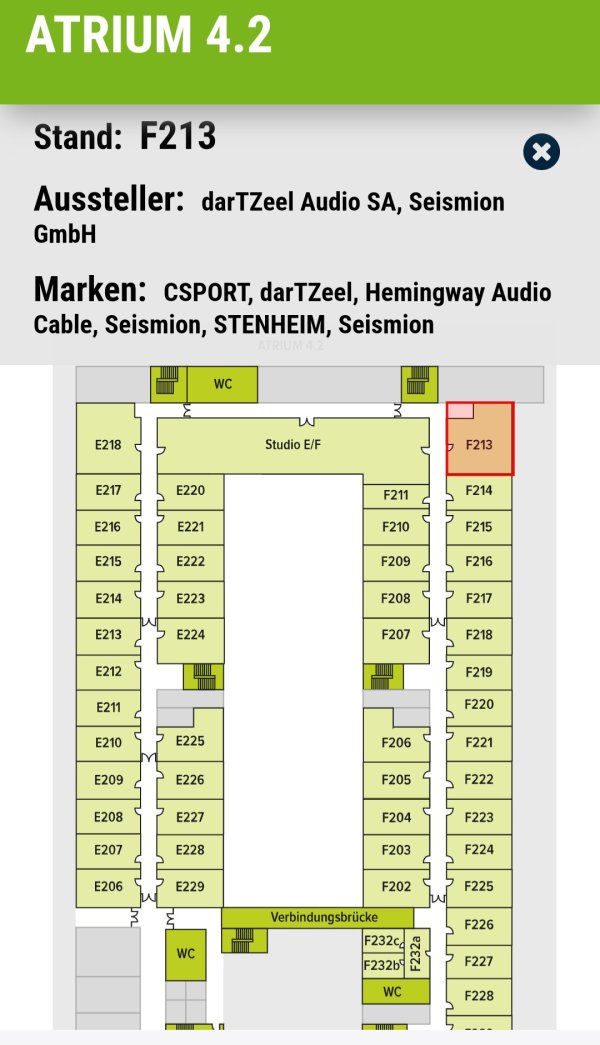
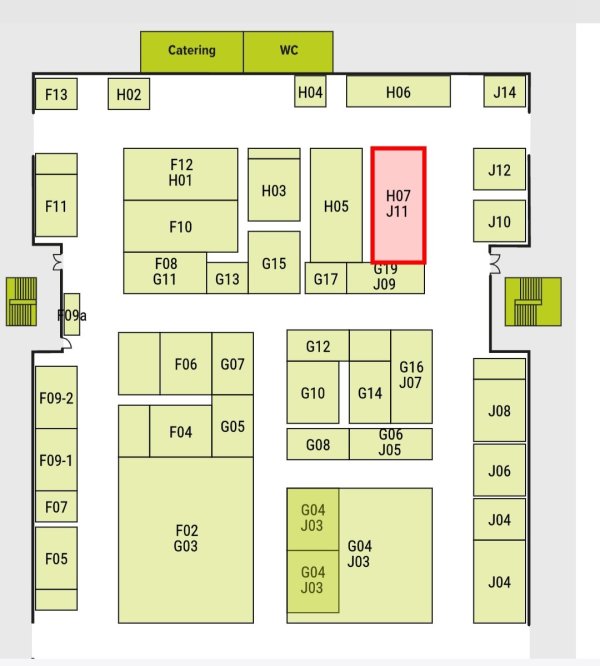
We are excited to announce that Seismion has its latest models of active vibration isolators on display at the following rooms:
- Atrium 4.2, F 213: as co-exhibitor with darTZeel
- Hall H 2, H 07 / J 11 as co-exhibitor with Extreme Audio
Beside that, also the New Reference turntable, a result of the cooperation between Thorens and Seismion, will be shown at the Thorens booth
H 3, M06/N05/M06N05
Our isolators are used under various equipment like turntables, DAC's, amplifier and even loudspeakers. We also present some premiers of new products, so please come over to experience what a difference high-quality vibration isolation can make.
We are looking forward to meet you there in person!


Summary of Munich High-End, part 1
Sebastian and I are just back from Munich. It has been a busy week, but overall it was simply a great experience. We were also glad to meet some of you in person and have a closer discussion.
Let's start with the active stabilizer that we placed below the Sigma Acoustics MAAT speaker. In cooperation with Aldo Zaninello we tried for the first time our ATLAS units, which are originally designed for heavy payload systems in semiconductor industry, below his loudspeakers. It started as an experiment with unknown outcome. But very soon all participants realized what a huge improvement the active stabilizers achieved.
The Atlas units serve two functions: isolating the speakers against vibrations from the floor, and more importantly stabilizing them against vibrations generated by the speakers themselves. Typical active vibration isolators known in high-end audio would not be capable to achieve this result, since their active control forces are too small.
Certainly the ATLAS units are overdesigned for this task, but they showed what is possible. The bass was definitely much sharper, and booming was strongly reduced. The introduction of vibrations into the floor was eliminated, which means other objects like chairs, tables and boxes did not resonate. The improvement was so strong that Aldo did not want to miss them for the rest of the show.
In the near future, Seismion will bring out an high-end audio compatible product based on this.
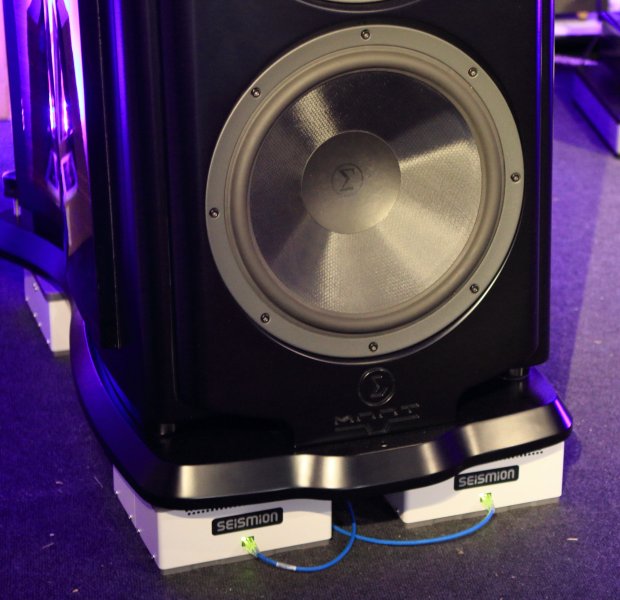

Sebastian and I are just back from Munich. It has been a busy week, but overall it was simply a great experience. We were also glad to meet some of you in person and have a closer discussion.
Let's start with the active stabilizer that we placed below the Sigma Acoustics MAAT speaker. In cooperation with Aldo Zaninello we tried for the first time our ATLAS units, which are originally designed for heavy payload systems in semiconductor industry, below his loudspeakers. It started as an experiment with unknown outcome. But very soon all participants realized what a huge improvement the active stabilizers achieved.
The Atlas units serve two functions: isolating the speakers against vibrations from the floor, and more importantly stabilizing them against vibrations generated by the speakers themselves. Typical active vibration isolators known in high-end audio would not be capable to achieve this result, since their active control forces are too small.
Certainly the ATLAS units are overdesigned for this task, but they showed what is possible. The bass was definitely much sharper, and booming was strongly reduced. The introduction of vibrations into the floor was eliminated, which means other objects like chairs, tables and boxes did not resonate. The improvement was so strong that Aldo did not want to miss them for the rest of the show.
In the near future, Seismion will bring out an high-end audio compatible product based on this.


It was so nice to meet Marcus and Sebastian in the show. They brought over 15 isolators and were demonstrated in three rooms.
Major brands like darTZeel, Rockport speaker and Sigma Acoustics were using Seismion isolators. They didn’t get enough to satisfy the demand. The result was undeniable. They didn’t want to turn them off.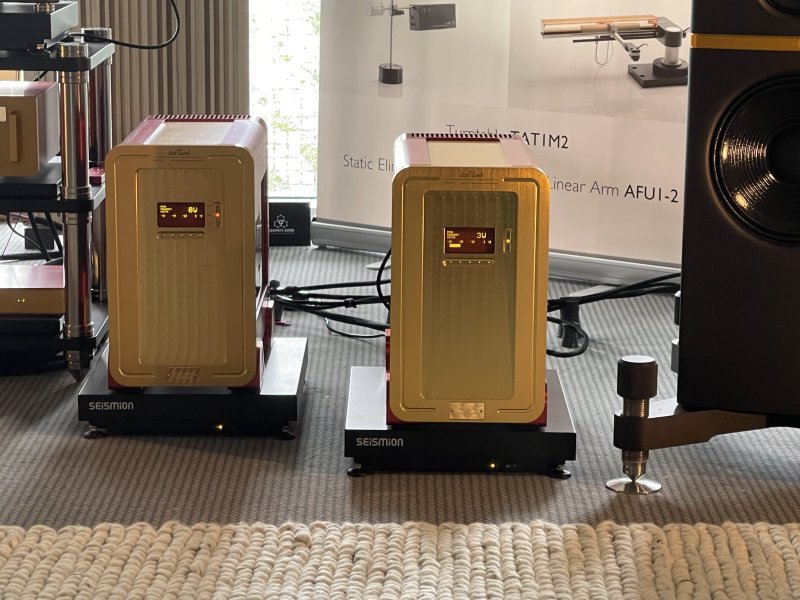
Major brands like darTZeel, Rockport speaker and Sigma Acoustics were using Seismion isolators. They didn’t get enough to satisfy the demand. The result was undeniable. They didn’t want to turn them off.

Last edited:
looks familiar.It was so nice to meet Marcus and Sebastian in the show. They brought over 15 isolators and were demonstrated in three rooms.
Major brands like darTZeel, Rockport speaker and Sigma Acoustics were using Seismion isolators. They didn’t get enough to satisfy the demand. The result was undeniable. They didn’t want to turn them off.View attachment 131080
Above photo also shows our new Audio Rack. It will be available in different finish, a gold version is being assembled right now. The whole production and polishing is done in house at Seismion. The rack includes some passive damping elements (see the lower two elements) and an especially solid mechanical construction, so that it forms the perfect base for our vibration isolators.
Michael Fremer just published his day 2 coverage of the Munich High-End, which also includes a visit at the Thorens New Reference turntable. It features the Seismion active isolation components, and can display the vibrations in real-time on the display, to make the difference between passive and active isolation immediately visible.
It starts around 1m:42s at the following link:
It starts around 1m:42s at the following link:
Yesterday I saw this video on Youtube, in which Michael Fremer compares his reference turntable with an Airforce III premium (all other components the same). The sound difference is obvious and easy to hear. My guess is that the difference comes from different isolation and acoustical feedback in both turntables?
Sebastian
Sebastian
I’d rather say it’s a matter of different turntable concepts, execution and price and the different matching between this arm/cartridge and the turntables. Too much is still different inspite of arm/cartridge being the same.
Does anyone know a link to the black box with green lights at the side of the right turntable? What’s this?
Does anyone know a link to the black box with green lights at the side of the right turntable? What’s this?
Last edited:
As there’s no cross-section sketch or photo of the internals of the Reaction plus anywhere Sebastian…how did you ensure that the top plate of the platform doesn’t vibrate or ring itself? Is it thick or damped?
And a theoretical question:
Would it be better to put the components of a turntable (platter base and tonearm base directly on the active platform than on the turntables base and then on the platform? Would the active platform eliminate the different vibrations of the platter and arm base as well or better as a base material of a turntable? Or is the active platform just for damping floor resonances but not so much for absorbing multiple different resonances of the turntable parts itself?
Assume a turntable like this, where the components are mounted on a square base plate (aimed to let resonances run dead).
 www.basisaudio.com
www.basisaudio.com
And a theoretical question:
Would it be better to put the components of a turntable (platter base and tonearm base directly on the active platform than on the turntables base and then on the platform? Would the active platform eliminate the different vibrations of the platter and arm base as well or better as a base material of a turntable? Or is the active platform just for damping floor resonances but not so much for absorbing multiple different resonances of the turntable parts itself?
Assume a turntable like this, where the components are mounted on a square base plate (aimed to let resonances run dead).
Transcendence – www.basisaudio.com
What passive platform do you suggest sounds better?I heard Seismion platforms under a couple of amps and a turntable. I’m sorry to say that but it sucks the life out the music and reduce dynamics dramatically. If you have a bass and/or midbass thumb because of speakers or room you can be fooled by reduced dynamics but it is impossible to like the sound. Surprisingly when you turn it off it starts to sound better. Of course not as good as any other passive platform. I’m glad that it works for many people. Please listen again.
BTW there can be many question that something went wrong with our trial. No, we tried Seismion platforms the correct way, nothing was wrong, no component, speakers, room, electricity or our ears have problems.
I have a Seismion and I go back and forth from on to off and I much prefer on. Maybe it’s something to do with your system. I know of a few guys that use them under every component and the life wasn’t sucked out of anything.
I answered this on #201What passive platform do you suggest sounds better?
Unfortunately that's not the correct way of evaluating it. The correct way is: component over Seismion and it's on vs component over the rack/platform or on the floor.I have a Seismion and I go back and forth from on to off and I much prefer on.
I'm happy for them. I hope they didn't just turn Seismion on and off when reaching the above conclusion.I know of a few guys that use them under every component and the life wasn’t sucked out of anything.
In fact, Helmut Thiele, who is using a special version of our Reactio for his own turntable "Thiele TT01", is doing exactly the way you suggest: one turntable directly on the rack, a second one on his active (Seismion) platform. For all his auditions at distributors and dealers, the audience was immediately aware of the huge improvement due to the isolation. We have also witnessed it once, and honestly: it exceeded all our expectations!I answered this on #201
Unfortunately that's not the correct way of evaluating it. The correct way is: component over Seismion and it's on vs component over the rack/platform or on the floor.
I'm happy for them. I hope they didn't just turn Seismion on and off when reaching the above conclusion.
We also know of some people who tried our isolator under a Dohmann Helix One turntable. As you might know, this turntable uses the passive isolation system from MinusK. After placing our Reactio below, a further improvement was clearly achieved.
Marcus
Pleased to hear some people are testing it the right way.In fact, Helmut Thiele, who is using a special version of our Reactio for his own turntable "Thiele TT01", is doing exactly the way you suggest: one turntable directly on the rack, a second one on his active (Seismion) platform. F
This is the Thiele TT01 setup at Axpona 2024 in the Wynn Audio room. On the left side there is an ADB01-isolator based on a Seismion Reactio. Find some more phots here: https://parttimeaudiophile.com/2024/04/30/wynn-audio-and-thiele-axpona-2024/
Sebastian
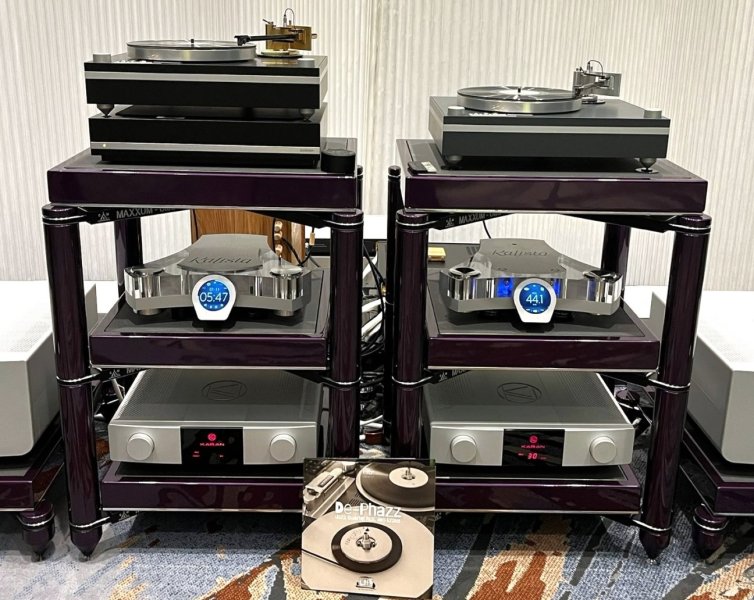
Sebastian

Unfortunately I didn't find any, Helmut did some listening presentations. The rest of the time the isolated one was playing. Maybe someone attended the session? Nevertheless, the difference is basically similar to the comparison of the OMA and Techdas Air-force III by Michael Fremer, but even easier to hear.Is there also a feature somewhere where they describe what they heard in the comparison?
Sebastian
Similar threads
- Replies
- 19
- Views
- 1K
- Replies
- 31
- Views
- 5K
- Replies
- 3
- Views
- 3K
- Replies
- 32
- Views
- 10K
- Replies
- 1
- Views
- 2K
| Steve Williams Site Founder | Site Owner | Administrator | Ron Resnick Site Owner | Administrator | Julian (The Fixer) Website Build | Marketing Managersing |



